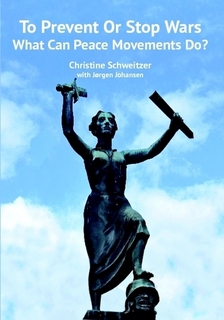To Prevent or Stop Wars – What Can Peace Movements Do?
REVIEWS, 28 Nov 2016
To Prevent or Stop Wars: What Can Peace Movements Do? By Christine Schweitzer and Jørgen Johansen, Irene Publishing, September 2016, 142 pp.
 The present chair of War Resisters’ International, Christine Schweitzer, and Jørgen Johansen have just published a book on one of the key questions for peace movements: Have they ever prevented or stopped a war?
The present chair of War Resisters’ International, Christine Schweitzer, and Jørgen Johansen have just published a book on one of the key questions for peace movements: Have they ever prevented or stopped a war?
This book studies examples of peace movements of the last 110 years, from the conflict between Norway and Sweden in 1905 to the debate on military intervention in Syria in 2013.
It looks at the impact these movements have had on the prevention or the ending of wars. It looks at the impact these movements may have had on the prevention or the ending of wars their own governments were engaging in. – Norway-Sweden 1905 – the movement against the Vietnam war in the 1960s and early 1970s – the movement against the support of the Contras in Nicaragua in the 1980s – the peace movement of the 1980s against nuclear weapons – the case of the Women in White in Liberia in 2002-2003 – the movement against the Iraq war in 1991 – the movement against the Iraq war in 2003.
_________________________________
Jørgen Johansen is a nonviolence author/activist, editor of Irene Publishing, and a member of the TRANSCEND Network from Norway.
DISCLAIMER: The statements, views and opinions expressed in pieces republished here are solely those of the authors and do not necessarily represent those of TMS. In accordance with title 17 U.S.C. section 107, this material is distributed without profit to those who have expressed a prior interest in receiving the included information for research and educational purposes. TMS has no affiliation whatsoever with the originator of this article nor is TMS endorsed or sponsored by the originator. “GO TO ORIGINAL” links are provided as a convenience to our readers and allow for verification of authenticity. However, as originating pages are often updated by their originating host sites, the versions posted may not match the versions our readers view when clicking the “GO TO ORIGINAL” links. This site contains copyrighted material the use of which has not always been specifically authorized by the copyright owner. We are making such material available in our efforts to advance understanding of environmental, political, human rights, economic, democracy, scientific, and social justice issues, etc. We believe this constitutes a ‘fair use’ of any such copyrighted material as provided for in section 107 of the US Copyright Law. In accordance with Title 17 U.S.C. Section 107, the material on this site is distributed without profit to those who have expressed a prior interest in receiving the included information for research and educational purposes. For more information go to: http://www.law.cornell.edu/uscode/17/107.shtml. If you wish to use copyrighted material from this site for purposes of your own that go beyond ‘fair use’, you must obtain permission from the copyright owner.